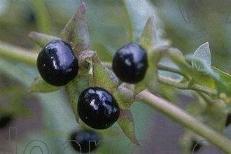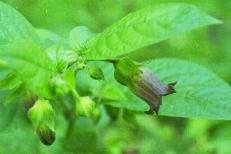Deadly Nightshade (Belladonna)
Name
 "Atropa
Belladonna" is the Latin for this unusual plant. The great
naturalist, Linneaeus, named it this; he is reputed to have been so
familiar with the nature and properties of plants that he was almost
always able to find amazingly appropriate names for them. "Atropa
Belladonna" is the Latin for this unusual plant. The great
naturalist, Linneaeus, named it this; he is reputed to have been so
familiar with the nature and properties of plants that he was almost
always able to find amazingly appropriate names for them.
Atropa Belladonna
is a good example of this because the generic name refers to the
Greek Fate Atropos, the inflexible one, who cuts the thread of life.
The species name is somewhat debated about; "Belladonna"
is Spanish for ‘beautiful woman’ and also means the same in
Italian. It most probably refers to the fact that ladies in the
Spanish and Italian court used the juice of the plant which contains
atropine, dissolved in water, and ingested, to dilate their pupils
to make them look more dreamy and beautiful.
Description
Native to central
and southern Europe. Light green plant likes plenty of shade. Bell
shaped flowers give way to large, soft, shining black berries with
purple juice. All parts of the plant are potentially toxic. Dry leaf
contains atropine and scopalamine which are narcotic and
antispasmodic in effect. A very charming and insidious plant.
Cultivation
 Extra care. Soak
seed for one day in water at room temperature, chill for 24 hours,
then sow in the greenhouse. Likes partial to full shade. Space
plants 2 feet apart. Grows 2 to 3 feet tall. Deadly nightshade has
gone by many names, including belladonna, Devil's cherries, Naughty
Man's cherries and Devil's Herb. The plant can take on the form of
an enchantress of great beauty. The plant requires rich, moist soil,
plenty of fertilizer and a weed free environment. Extra care. Soak
seed for one day in water at room temperature, chill for 24 hours,
then sow in the greenhouse. Likes partial to full shade. Space
plants 2 feet apart. Grows 2 to 3 feet tall. Deadly nightshade has
gone by many names, including belladonna, Devil's cherries, Naughty
Man's cherries and Devil's Herb. The plant can take on the form of
an enchantress of great beauty. The plant requires rich, moist soil,
plenty of fertilizer and a weed free environment.
Medical
properties
Atropa
belladona is extremely poisonous.Deadly nightshade is another name
given to belladonna. It is a highly toxic plant
Toxins
are present in all parts of the plant; especially in the seeds,
roots and leaves.
It
has been known for centuries as a poison, and is also used as a
source for some medicines, such as hyoscyamine, but it is too
dangerous to use except by trained physicians.
The
symptoms from belladonna poisoning include a dry mouth and hot,
flushed skin, nausea, convulsions, and delirium.
Homoeopaths
prescribe Belladonna for illnesses that have similar symptoms. All
parts of the belladonna plant are used in the Homoeopathic remedy.
The plant is crushed and pressed with the juice mixed with alcohol
to dilute it.
|
